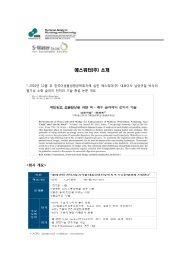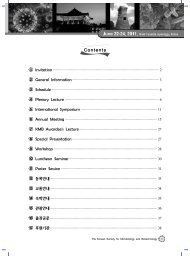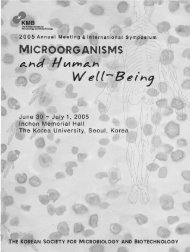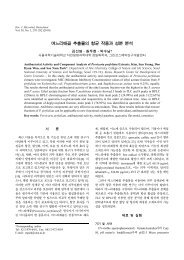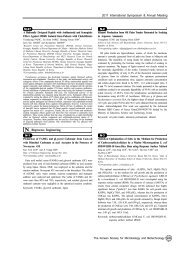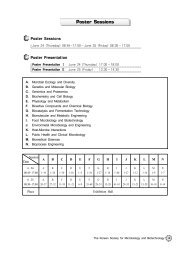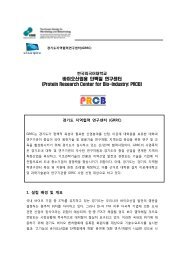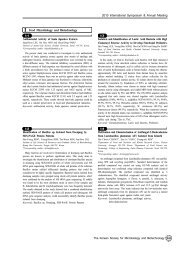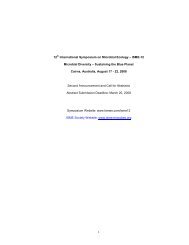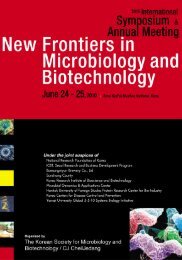J_Environmetal Microbiology and Engineering
J_Environmetal Microbiology and Engineering
J_Environmetal Microbiology and Engineering
You also want an ePaper? Increase the reach of your titles
YUMPU automatically turns print PDFs into web optimized ePapers that Google loves.
Bioelectrochemical Fixation of CO2<br />
Bo Young JEON 1 , Ji-Won CHOI 1 , Il Lae JUNG 2 <strong>and</strong> Doo Hyun PARK* 1<br />
1<br />
Department of Chemical <strong>and</strong> Biological <strong>Engineering</strong>, Seokyeong University,<br />
Seoul 136-704, Korea. 2 J-40<br />
Department of Radiation Biology, Environmental<br />
Radiation Research Group, Korea Atomic Energy Research Institute, Daejeon<br />
305-353, Korea.<br />
*Corresponding author: baakdoo@skuniv.ac.kr<br />
For the isolation of CO2-fixing bacteria using electrochemical reducing<br />
power (ERP), a plate-type electrochemical bioreactor (PEB) was employed.<br />
Soluble neutral red (NR) was used as an electron mediator for<br />
carbonate-basal agar medium (CBAM) prepared in the PEB. For test of<br />
bacterial CO2 fixation using the ERP, a single-compartmented<br />
electrochemical bioreactor (SCEB) was employed. NR immobilized in the<br />
graphite felt cathode (NR-cathode) was used as an electron mediator for<br />
carbonate-basal broth medium (CBBM) prepared in the SCEB. Two<br />
bacterial genera capable of electrochemically fixing CO2 were isolated<br />
using the PEB <strong>and</strong> cultivated using the SCEB. The isolated bacterial species<br />
were 99% identified with Achromobacter sp. <strong>and</strong> Alcaligenes sp.<br />
Approximate 150 ml of CO2 per day was consumed by 300 ml of the<br />
mixed culture of Achromobacter sp. <strong>and</strong> Alcaligenes sp. grown<br />
electrochemically in the SCEB. Acknowledgement This work was<br />
supported by the New &Renewable Energy of the Korea Institute of Energy<br />
Technology Evaluation <strong>and</strong> Planning (KETEP) grant funded by the Korea<br />
governmental Ministry of Knowledge Economy (2010T1001100334)<br />
Keywords: CO2-fixing bacteria, neutral red, electrochemical reducing<br />
power, Alcaligenes sp., Achromobacter sp.<br />
Inactivation of Chloramphenicol <strong>and</strong> Florfenicol by a Novel<br />
Chloramphenicol Hydrolase from Alluvial Soil Metagenome<br />
Weixin TAO 1 , Myung Hwan LEE 2 , Jing WU 2 , Nam Hee KIM 2 ,<br />
Jin-Cheol KIM 3 , Eul Chul HWANG 2 <strong>and</strong> Seon-Woo LEE* 1,2<br />
1<br />
Department of Medical Bioscience, Dong-A University, Busan 604-714, South<br />
Korea. 2 Department of Applied Biology, Dong-A University, Busan 604-714,<br />
South Korea. 3 J-41<br />
Chemical Biotechnology Research Center, KRICT, Daejeon<br />
305-343, South Korea.<br />
*Corresponding author: Seonlee@dau.ac.kr<br />
In a previous study, EstDL136 isolated from alluvial soil metagenome<br />
was redefined as chloramphenicol (Cml) acetate esterase, on account of<br />
its capability of Cml reactivation that against Cml acetyltransferase (CAT).<br />
Further investigation of Cml catalytic activity in the absence of CAT<br />
revealed that Cml was metabolized by EstDL136. The metabolite was<br />
identified as p-nitrophenylserinol by LC-MS <strong>and</strong> 1 H-NMR, suggesting a<br />
promiscuous amidase activity of the enzyme. Purified EstDL136 catalyzed<br />
Cml hydrolysis when they were co-incubated. Residues were detected by<br />
HPLC, which showed that Cml was gradually hydrolyzed <strong>and</strong> the<br />
hydrolysate, p-nitrophenylserinol was concurrently generated. EstDL136<br />
also hydrolyzed florfenicol (Ffl), the synthetic florinated analog of Cml<br />
that was resistant to CAT. Therefore, Escherichia coli was tolerant to<br />
Cml or Ffl when estDL136 was expressed, <strong>and</strong> duration of the lag phase<br />
was highly correlated with the concentrations of supplemented antibiotics<br />
(Cml, Ffl), indicating that estDL136 mediated the amphenicols resistance.<br />
This study primarily reported a novel bacterial Cml hydrolase that also<br />
hydrolyzes Ffl, conferring Cml <strong>and</strong> Ffl resistance to the E. coli.<br />
Keywords: Chloramphenicol, Florfenicol, Hydrolase<br />
406 www.kormb.or.kr<br />
J-42<br />
Efficacy of Combined Application of Entomopathogenic Fungal<br />
Conidia <strong>and</strong> Botanical Insecticides for Aphid Control<br />
Tuan anh PHAM <strong>and</strong> Keun KIM*<br />
Dept. of Bioscience <strong>and</strong> Biotechnology, Univ. of Suwon, Gyeonggi-do 445-743,<br />
Korea.<br />
*Corresponding author: ptanh140380@yahoo.com<br />
Some botanical insecticides prepared from neem, derris, garlic <strong>and</strong><br />
chinaberry were evaluated for the influence of the botanical insecticides<br />
on susceptibility of conidia of Beauveria bassiana by the germination<br />
ratio of conidia. The results demonstrated that botanical insecticides<br />
significantly reduced the germination ratio of conidia <strong>and</strong> it could not<br />
be mixed with the conidia in oil-based formulation for long-term storage.<br />
After that, the virulence of oil-based formulation of conidia in combination<br />
with botanical insecticides against aphid Myzus persicae was examined<br />
with detached leaf test. The botanical insecticide was mixed with the<br />
oil-formulated conidia just before spraying <strong>and</strong> the result showed that<br />
the combined application of two insecticides significantly increased the<br />
mortality of the aphid.<br />
Keywords: Beauveria bassiana conidia, botanical insecticides, aphid control<br />
Seasonal Escherichia coli Genotypes Determined by Horizontal<br />
Fluorophore-Enhanced rep-PCR (HFERP) in the Yeongsan River<br />
Basin of South Korea<br />
Jeonghwan JANG 1 , Tatsuya UNNO 1 , Seung Won LEE 1 , Kyung Hwa CHO 1 ,<br />
Michael J. SADOWSKY 3,4 , GwangPyo KO 5 , Joon Ha KIM 1 <strong>and</strong><br />
Hor-Gil HUR* 1,2<br />
1<br />
School of Environmental Science <strong>and</strong> <strong>Engineering</strong>, Gwangju Institute of Science<br />
<strong>and</strong> Technology, Gwangju, Republic of Korea. 2 International Environmental<br />
Research Center, Gwangju Institute of Science <strong>and</strong> Technology, Gwangju, Republic<br />
of Korea. 3 Department of Soil, Water <strong>and</strong> Climate, University of Minnesota, St.<br />
Paul, Minnesota, USA. 4 BioTechnology Institute, University of Minnesota, St. Paul,<br />
Minnesota, USA. 5 J-43<br />
Department of Environmental Public Health, Seoul National<br />
University, Republic of Korea.<br />
*Corresponding author: hghur@gist.ac.kr<br />
Seasonal <strong>and</strong> spatial variation in the genotypic diversity of 3,480 Escherichia<br />
coli isolates obtained from the Yeongsan River basin in South Korea was investigated<br />
by using the horizontal fluorophore-enhanced rep-PCR (HFERP) DNA fingerprinting<br />
technique. The MDS analysis, done based on HFERP DNA fingerprints, showed<br />
that E. coli isolates obtained in October through December clustered tightly, while<br />
those obtained in other sampling periods were more genetically diverse. SOMs<br />
analysis, done using the 10 most frequently-isolated E. coli genotypes, showed the<br />
occurrence of season-specific E. coli genotypes <strong>and</strong> the main SOMs clusters were<br />
most influenced by temperature, strain diversity, <strong>and</strong> biochemical oxygen dem<strong>and</strong>.<br />
Diversity among E. coli genotypes tended to decrease as water temperature decreased,<br />
<strong>and</strong> the numbers of E. coli genotypes observed in urban area were greater, more<br />
diverse, <strong>and</strong> less dependent on water temperature than those obtained from agricultural<br />
areas. This work was supported by the National Research Foundation of Korea Grant<br />
funded by the Korean Government (MEST) (NRF-R1A5A004-2010-0029224), <strong>and</strong><br />
also by the Korea Environmental Technology &Industry Institute (KEITI) as the<br />
Next Generation Eco Innovation Technology Development Project.<br />
Keywords: Escherichia coli, Yeongsan River, Horizontal<br />
Fluorophore-Enhanced rep-PCR





